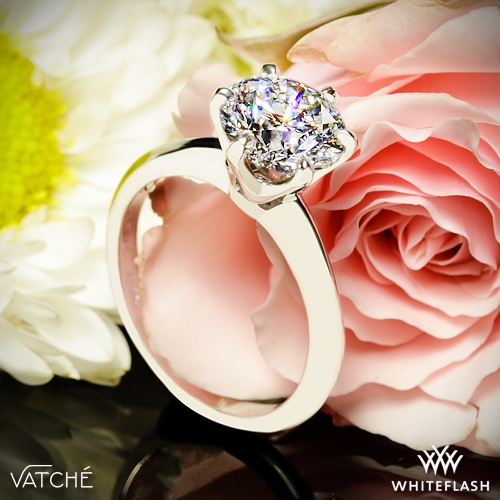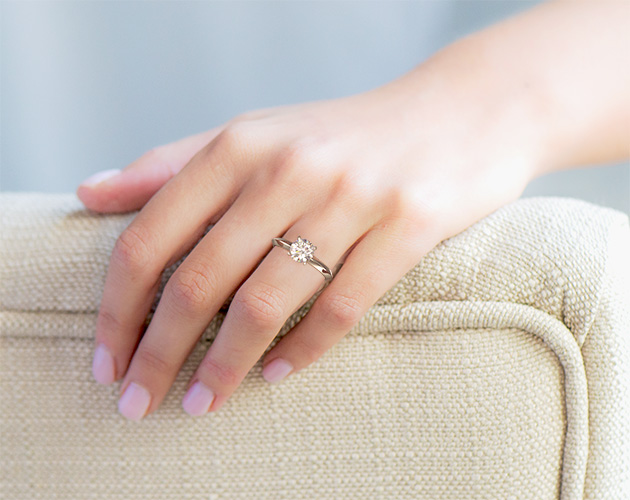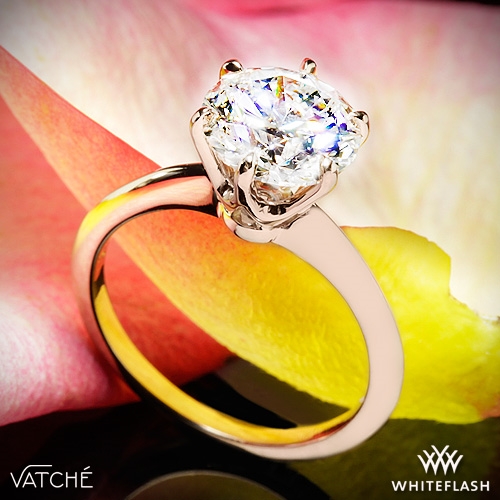
Choosing a metal for your jewelry and engagement ring settings comes down to three key features; personal taste, durability and budget. Unlike selecting a diamond, which has a whole spectrum of possibilities and choices to make, selecting a metal is fairly straightforward. There are, however, a few helpful tips and lesser known features of precious metals that are worth considering when you make your selection.
Platinum
Starting with the one of the most expensive metals used to set jewelry, platinum is a strong contender for engagement rings due it its purity (around 95%-98%) and naturally white appearance. Platinum is quite rare and its chemical properties naturally lend themselves to fine jewelry.
Pros
- Platinum is naturally white. This means it does not require plating/re-plating, unlike white gold
- Hypoallergenic
- Resistant to tarnishing and corrosion
- A lustrous metal, platinum can be polished to a high, metallic shine or given a brushed/textured finish
- Platinum is less vulnerable to ‘thinning’ – it is highly durable so little of the metal is lost with wear the tear. It simple develops a unique patina than can be polished back to a high shine when needed
- Platinum is denser than gold. This means it feels weightier on the hand which some wearers prefer
- Synonymous with purity, luxury and wealth
Cons
- Historically more expensive than gold (around 40%-50%) this is due to its heft, however gold is becoming more expensive (Covid 19) and in some cases can be more expensive
- Will require polishing to maintain sheen
White Gold
White gold used in jewelry is generally found in three purities; 10k, 14k and 18k. Gold by itself is fairly soft so it is mixed with durable metals such as zinc and copper, to make it more hardwearing. 18 karat gold is 75% pure and this level decreases when you reach 14k and 10k (and 9k, which it sometimes offered too). Gold is naturally yellow tone, so rhodium plating is used to cover the metal to give it a white appearance. A platinum setting and a white gold setting will look identical but will have a considerably difference in price.
Pros:
- Historically more affordable than platinum
- Durable enough for every day wear
- Extremely popular (meaning you will find many settings crafted from white gold)
Cons
- Over time, the rhodium will wear away and white gold will begin to take on a yellow hue. It must be rhodium plated again to retain its white sheen
- Gold is often mixed with nickel which can cause allergic reactions for wearers. This becomes more problematic when purity decreases (a 9k gold ring is more likely to cause a reaction than 18k)
Yellow Gold
 Yellow gold is mixed with metals like copper and zinc. Yellow gold can be found all the way up to 24k (99.9%) pure. In the USA, 24k is rarely used in fine jewelry as it is so soft (it can be bent by hand) but across India and other parts of Asia, it is prized for its bright, intense yellow color.
Yellow gold is mixed with metals like copper and zinc. Yellow gold can be found all the way up to 24k (99.9%) pure. In the USA, 24k is rarely used in fine jewelry as it is so soft (it can be bent by hand) but across India and other parts of Asia, it is prized for its bright, intense yellow color.
Lower purity yellow gold (such as 10k) is more durable but delivers a less intense color. An 18k yellow gold setting is a good balance between color, purity and durability.
Pros
- The most hypoallergenic of all colors of gold
- Yellow gold is traditional and looks beautiful in vintage-inspired settings
- The warm tone makes it more forgiving for diamonds – in other words, a lower color diamond will look white against a yellow gold setting
- Malleable, making it easier for jewelers to work with
Cons
- Requires polishing to remove scratches
Rose Gold
Like white gold, rose gold is an alloy. It is the high percentage of copper than give it a pinkish, rosy tone. The percentage of copper will dictate the color of the metal.
| 18K Pink Gold | 75% gold | 20% copper | 5% silver |
| 18K Red Gold | 75% gold | 25% copper | 0% silver |
| 18K Rose Gold | 75% gold | 22.25% copper | 2.75% silver |
The percentage of copper used is generally down to the manufacturer and there are no hard and fast rules about how much should be used. Much of it will come down to personal reference.
Pros
- The most durable color of gold due the high percentage of copper
- An affordable metal
- Rose gold has seen a huge rise in popularity so it is bang on trend
- Works beautifully with colorless diamonds and pastel colored diamonds and gemstones (such as morganite)
Cons
- Not hypoallergenic so may cause allergic reactions in some wearers
- Unlike yellow and white gold which can be paired with many colors, rose gold can clash with some gemstones such as blue sapphires
Which Metal Should I Choose for my Setting?
If you’re deciding between platinum and white gold, price is likely to be the deciding factor. Both metals require basic maintenance (annual polishing/rhodium plating) buy beyond this there is little difference. Men tend to prefer platinum for their wedding bands as they feel more substantial on the hand, but this is not a definitive rule.
If you are considering other colors of gold, go for 14k or 18k – the rest is entirely up to you.

I’m Louis Jacobs, the creator of Diamond Expert, a platform where I share my lifetime’s knowledge of diamonds. Born and raised in Antwerp, Belgium, the world’s diamond hub, my fascination with these precious gems began at a young age. I spent over three decades in the diamond industry, earning the reputation of a trusted advisor among friends and family for diamond purchases, particularly engagement rings. Now retired, I’m dedicated to providing online guidance to make your diamond buying experience informed and successful.




